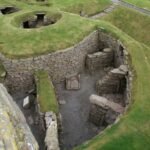In the heart of Perthshire, just a few kilometres from the site where ancient Scottish kings were once crowned, a sacred sandstone slab is drawing fresh attention — and not just from history buffs or nationalist romantics. New research suggests that the Stone of Destiny, Scotland’s most venerated royal relic, is even more fragmented — and storied — than previously known.
Once spirited away by King Edward I, blown up by suffragettes, and broken during a nationalist heist, the 150kg block has become not just a symbol of Scotland’s ancient monarchy, but also a complex touchstone in Britain’s centuries-old tussle over sovereignty, identity, and power.
Now, fresh slivers are emerging — quite literally.
“There are more”: The mystery of the missing fragments
According to Professor Sally Foster of Stirling University, a new academic study due this July will reveal that the known 34 fragments of the stone — long rumoured to be scattered among Scottish nationalists — may only be part of a wider, previously unknown haul.
“Bertie Gray talked of 34,” Foster said, referring to the nationalist Glasgow stonemason who famously repaired the stone in the 1950s and is believed to have secretly distributed chips to comrades. “But there are more.”
She declined to go into specifics, citing confidentiality ahead of the study’s release. “It’s too early: it would be unfair to those who have come forward,” she said. “But there will be more of a story to tell.”
The discovery opens a new chapter in the Stone’s already extraordinary journey — one that has crisscrossed borders, legends, and revolutions.

From Scone to Westminster and back again
Formally known as the Stone of Scone (pronounced “scoon”), the relic was seized by England’s Edward I in 1296 and installed in Westminster Abbey, beneath the coronation chair. There it remained for 700 years — an enduring emblem of English conquest and British unity.
During that time, monarchs including Elizabeth II and Charles III were crowned above it, often to the quiet unease of Scottish nationalists. Even the UK government today avoids declaring ownership outright — referring to it as a “loan” when it travels south for coronations — for fear of inflaming constitutional tensions.
Its storied timeline includes:
-
1296: Seized by Edward I during the Wars of Scottish Independence
-
1950: Stolen from Westminster by four Glasgow students on Christmas Day
-
1951: Recovered in Scotland, draped in a Saltire, and eventually returned
-
1996: Officially “loaned” back to Edinburgh on the 700th anniversary of its removal
-
2023: Temporarily relocated for the coronation of King Charles III
-
2024: Permanently displayed in Perth Museum after a £27 million renovation
Secret chips, stolen symbols
The Stone famously split in two during the 1950 heist — a bold stunt by nationalist students that briefly saw the Anglo-Scottish border closed for the first time in modern history. The repair was carried out by Bertie Gray, a skilled mason and nationalist sympathiser who allegedly retained fragments from the original stone.
One confirmed shard surfaced only last year in a cupboard at the Scottish National Party’s headquarters, having been given to former leader Alex Salmond some 16 years earlier.
Following that revelation, Stirling University issued a public call in January for others holding fragments to come forward. The appeal, it seems, has unearthed more than expected.
Whether these new pieces are legitimate or folklore turned artefact remains to be confirmed — but the symbolic weight is undeniable.
A royal relic returns home
Today, the Stone of Destiny resides at the newly reopened Perth Museum, a sleek £27 million cultural centre designed to reinvigorate the city’s historic identity as the cradle of Scottish royalty.
Located just 4km from Scone Palace, the museum sits near the ancient coronation site of kings including Macbeth — the real-life version, not Shakespeare’s tragic invention — and his successors in the Kingdom of Alba, the medieval precursor to Scotland.
Perth’s renaissance as a heritage hub coincides with a new exhibition dedicated to Macbeth, opening later this month and running through August. The display will explore both the 11th-century king’s reign and his transformation into one of literature’s most iconic characters.
Beside it, the Stone of Destiny will sit in a custom-built vault — protected, studied, and displayed as a centrepiece of national memory and myth.
Mysticism vs geology: Where did the Stone come from?
Legend says the Stone came from the Holy Land, originally used as Jacob’s Pillow by the biblical patriarch who dreamt of a ladder to heaven. Other stories suggest it passed through Ireland’s Hill of Tara before arriving in Scone.
But science offers a more grounded theory.
Modern testing confirms that the Stone is made of Perthshire sandstone — local and unremarkable geologically, but sacred by virtue of its use and symbolism.
Even the museum concedes that the first documented use of the stone for coronation purposes came in 1249, during the inauguration of Alexander III. That’s long after Macbeth’s reign (1040–1057), casting doubt on whether he ever sat upon it.
Still, the Stone’s mystical aura endures, nourished by centuries of royal pomp, nationalist pride, and political symbolism.
Fragments of the future
The emerging evidence of more fragments scattered across Scotland — and perhaps beyond — raises questions not only of provenance, but of custodianship.
Should they be gathered and displayed? Should they be left hidden, continuing as private tokens of resistance and identity? What happens if rival claimants assert possession over parts of the Stone?
For now, researchers are focused on cataloguing and verifying what they can. But the political undercurrents are inescapable.
As Scotland continues to debate its future in the UK, and as nationalist sentiment waxes and wanes, the Stone of Destiny remains what it always has been — a rock around which Scotland’s past, present, and future collide.


















